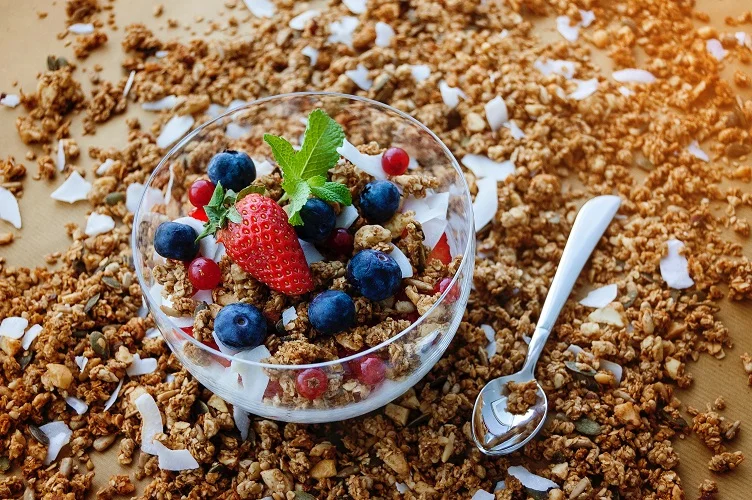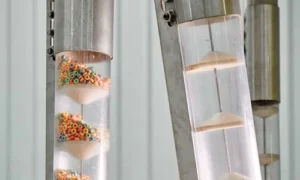The processing of breakfast cereals is a fascinating and integral aspect of the food industry. From the selection of grains to the various methods of preparation, breakfast cereals have evolved into a diverse and beloved category of products consumed by millions worldwide. We will unravel the secrets behind the processing of breakfast cereals and gain insight into the innovation and craftsmanship that go into creating these beloved breakfast staples.
What is Considered a Breakfast Cereal?
Breakfast cereal is a type of processed food that is made primarily from grains and is designed to be consumed with milk as a main dish in the mornings. There are two main categories of breakfast cereals, distinguished by their preparation method. Hot cereals, which need a short cooking time, are not as popular as their cold, ready-to-eat counterparts. Hot cereal recipes have been present in various forms since ancient times when whole grains were ground and cooked in water in order to produce different types of porridge or gruel.
The History Behind Breakfast Cereals
In contrast, cold cereals emerged much later during the late 19th century, partly influenced by religious beliefs. The early precursor to modern cereals was the “Graham cracker,” developed by Sylvester Graham, an American clergyman and vegetarian diet advocate, in 1829. Fast-forward to 1863, Dr. James Caleb Jackson invented the first cold cereal called “granula.” It was a dry, whole-grain breakfast cereal made by baking graham flour and bran, which needed about 20 minutes of soaking in milk or water before consumption, making it more convenient than traditional hot cereals.
Shortly afterward, physician John Harvey Kellogg came across granula and developed a similar cereal with his brother, W. K. Kellogg. They created the first precooked, flaked cereal, initially made from wheat but later replaced with corn due to its popularity. The Kellogg brothers’ cereal manufacturing company was established in 1906 and became a tremendous success, selling more than one million cases of breakfast cereal by 1909. Another notable figure in the early breakfast cereal industry was Charles William Post, who invented Grape Nuts in 1897, Post Toasties in 1904, and Post 40% Bran Flakes in 1922. His company, Postum Cereal Co. Ltd., later became known as the General Foods Corporation.
The success of Kellogg’s and Post’s companies led to the emergence of several other breakfast cereal manufacturers during the early 20th century. However, most of these businesses eventually failed, while Kellogg’s and Postum Cereal (General Foods Corporation) continued to thrive. Their success was attributed to effective advertising campaigns that highlighted the convenience and taste of their products, in addition to their health benefits.
Furthermore, the introduction of cornflakes, which were more appealing than wheat flakes, contributed to their popularity. Since then, breakfast cereal has grown in variety and popularity, ending up in most American households.
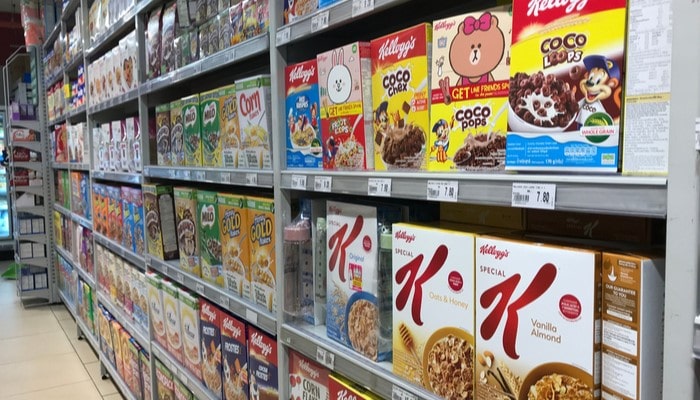
Breakfast Cereal Market Trends and Statistics
Today, the breakfast cereal market is at an all-time high. In 2020, the industry is expected to generate a revenue of $62.7 billion. The US accounts for about a third of this revenue, at around $20.1 billion. The industry is also growing at about 4.1% compound annual growth rate (CAGR). As mentioned earlier, breakfast cereal is a widely popular product category in mature markets like the United States and Europe. However, there is still a lot of room for growth in other areas of the world, particularly in Asia, Africa, and the Middle East. In many of these regions, breakfast cereal is presented as a sort of novel food option and alternative to traditional foods that are typically available.
Looking at the US Market
When it comes to the US, cereal manufacturers are looking into new ways to increase consumption and keep their customers engaged. One of these strategies is to reposition cereal as not only breakfast food but also as something that can be eaten as a dessert or even a snack. Another strategy is to introduce new flavors as a play on millennial nostalgia. For example, Hostess Donettes was introduced by Post Holdings, Caticorn by Kellogg’s, and Cinnamon Toast Crunch Churros by General Mills.
Another trend that cereal manufacturers need to keep in mind is the increased customer demand for healthier, less-processed ingredients used in their recipes. This is particularly relevant in product development when it comes to mature markets, such as North America and Europe. There are niched breakfast cereal brands that cater to these trends and add value by incorporating probiotics, ancient grains, seeds, nuts, and other so-called superfoods.

Raw Materials That Are Used To Manufacture of Breakfast Cereals
The main raw material used in the production of breakfast cereal is grain. The most common types of grains used in the breakfast cereal industry are corn, wheat, oats, rice, rye, and barley. There are some types of hot cereal, such as plain oatmeal, and cold cereals, like shredded wheat, that use no other ingredients. However, breakfast cereals usually contain a multitude of other ingredients, based on the recipe and method of processing. Among these other ingredients, we can include salt, various types of sweeteners, yeast, coloring and flavoring vitamins, seeds, minerals, agents, preservatives, nuts, etc.
While certain natural cereals may be sweetened with concentrated fruit juice, the majority of other breakfast cereals opt for more conventional sweeteners, including white and brown sugar, corn syrup, or malt derived from barley. There is also a variety of other flavors and ingredients added to breakfast cereal, such as cinnamon, chocolate, various fruit flavors, marshmallows, dried fruit, nuts, and many others. When it comes to the added vitamins and minerals, these need to be added after cooking unless they are heat-resistant. Vitamin B1’s nutritional value, for instance, is reduced by about 90% when exposed to heat.

Processing of Breakfast Cereals
There are several stages that breakfast cereal goes through before it emerges as a final product. There are also several types of manufacturing processes, depending on the type of cereal, such as flaked, puffed, shredded, and more. Regardless of what the type of end product will be, the manufacturing process starts with preparing the grain. The processing of breakfast cereals involves a harmonious blend of technology, craftsmanship, and creativity, transforming grains into beloved and nutritious breakfast options enjoyed by people around the world.
At the cereal factory, the first step in the processing of breakfast cereals involves receiving the grain, which undergoes careful inspection and cleaning. Depending on the type of cereal being produced, some cereals use whole grains, while others process the grain through large metal rollers to remove the outer bran layer and create fine flour.
The selected grains, whether whole or in flour form, are then mixed with other ingredients in a large rotary pressure cooker. The cooking process in this stage is tailored to the specific type of grain being used, considering factors like rotation speed, time, and temperature to achieve the desired consistency and flavor.
After cooking, the grain needs to retain a certain amount of moisture to be shaped effectively. It is then transferred to a drying oven, where excess moisture is removed while retaining the ideal texture and form.
For certain cereal types using flour, the flour is combined with other ingredients and undergoes cooking extrusion. This process involves a heated housing with a long screw inside, which efficiently mixes the flour with the other ingredients while transporting the mix through the extruder.
The cooked dough emerges from the cooking extruder in the form of a continuous, elongated ribbon. This ribbon is precisely cut into pellets by a rotating knife, resulting in uniform shapes that are later processed similarly to the cooked grains mentioned earlier.
Regardless of the specific manufacturing process, the prepared grains or pellets are subjected to further steps, which may include flaking, puffing, or shredding, depending on the desired type of breakfast cereal. These processes add distinctive textures and shapes to the cereal, creating a wide variety of breakfast delights available to consumers.
Production of Flaked Cereal
Flaked cereals can be produced using either whole grains or extruded pellets. The fundamental process involves allowing the cooked grains or pellets to rest for several hours, allowing the moisture content to stabilize. Once this tempering phase is complete, the grains or pellets undergo immense pressure between two large metal rollers, resulting in their flattening. The obtained flakes are then conveyed to an oven, where they are exposed to hot air to remove excess moisture and achieve the desired flavor and color through toasting.
For flaked cereals made from whole grains, maintaining the appropriate grain size is crucial to ensure overall product quality. To enhance the flakes’ ability to withstand processing, it is common to incorporate unmodified corn starch into the mixture. The moisture content of flaked cereal after cooking should ideally be between 28 to 32%. The control of moisture and texture levels for whole-grain flaked cereal primarily occurs during the initial phases of cooking, drying, and tempering. Conversely, for extruded flakes, this control is mostly done after the extrusion process. Nevertheless, achieving an optimal moisture level of between 1 and 3% in the final product is essential to ensure the desired crunchiness and toughness.
Production of Puffed Cereal
Puffed cereal production involves a combination of rice and wheat and requires specialized equipment known as a “gun.” The process starts with cooking, cooling, and tempering the rice grains. Afterward, the grains are partially flattened using metal rollers, a technique known as “bumping.” They then undergo another round of drying before being transferred to a steam oven with high pressure (the one referred to as the “gun”). The sudden release of pressure causes the grains to puff up rapidly as they release steam.
At this stage, the puffed grains contain around 5 to 7% moisture, which needs to be reduced to a level between 1 and 3%. It’s important to consider that this type of cereal can easily absorb moisture, so it requires a protective coating and appropriate packaging materials to maintain its crispiness and prevent spoilage over time.
Production of Shredded Cereal
Shredded cereal is predominantly made from wheat, which undergoes a specific process to achieve its shredded form. Initially, the wheat is boiled in water to ensure thorough moisture penetration. Following this, the wheat is left to temper for a period of up to 24 hours before being passed through two metal rollers. These rollers are different from those used in flaked cereal production, consisting of one smooth roller and one grooved roller.
Adjacent to the grooved roller, a metal comb with a tooth inside each groove is placed. When the wheat passes through, these teeth shred the grains, creating a continuous ribbon-like texture. Subsequently, the ribbon is cut to the desired size and baked until it reaches the appropriate color and dryness.
The crucial step of tempering the cooked wheat for the specified duration ensures even moisture distribution and enables starch retrogradation, which plays a significant role in achieving the right texture for the cereal. Failing to temper the wheat adequately could result in shredded wheat that is excessively gummy and sticky, making it unsuitable for further processing.
Production of Granola
Granola is made by mixing and cooking grain with other ingredients, such as nuts, seeds, dried fruits, honey, malt extract, different flavors, and the alike. Unlike other types of cereal, granola also needs oil in the mix to allow the other ingredients to stick together. This process is known as agglomeration. The mixture will be cooked at temperatures between 300º to 425ºF to achieve a light browning and a moisture content of around 3%. Around 5% of inulin (a prebiotic fiber) and other carbohydrates may also be added to help with the binding. Once the cooking and drying processes are complete, the granola will be broken up into chunks.
Adding Coatings
After the initial processing phase, some cereals may be sprayed with a layer of coating with sweeteners, food coloring, flavors, vitamins, preservatives, and/or minerals. The commonly-used sugar coating in most cereals combines a sugar formula with an application method that regulates the right color, flavor, size, and structure of the sugar crystals when dry. Beet or cane sugar is typically used as a coating, but brown sugar or honey can also partially replace white sugar. Adding oil can also help prevent clumping.
Aside from making the cereal sweet, sugar coatings also provide an additional layer between the milk and cereal, thus prolonging their crispiness. Adding different starches, such as dextrin or maltodextrin, to the cereal’s surface will help improve the storage stability and not add any sweetness to the overall taste during the process. High-fructose corn syrup and crystalline fructose, on the other hand, can be used to provide sweetness and adhering properties for dry flavor-bit applications. In sweetened cereals, the coating’s visibility will also add some level of appeal to the consumer. As such, the coating can account for up to 50% of the cereal’s weight.

Packaging and Quality Control
While certain cereals, like shredded wheat, demonstrate resistance to moisture spoilage and can be directly placed in cardboard boxes, the majority of other cereals require airtight and waterproof plastic bags for packaging. These bags are then inserted into cardboard boxes to safeguard the cereals from spoilage. Present trends indicate that modern customers prioritize flexible packaging and sustainable materials.
In the packaging of breakfast cereals, traditional choices have involved rigid plastics. Traditional packaging materials include:
- Polyethylene,
- Polypropylene,
- Polyamide,
- Polyethylene terephthalate,
- Ethylene-vinyl alcohol.
However, a growing number of cereal manufacturing businesses are shifting their attention towards more sustainable alternatives, embracing plant-based packaging materials. This change reflects the industry’s commitment to eco-friendly practices and reducing its environmental impact. Options that have convenient packaging are also being considered, such as resealable, flexible, and stand-up bags. These options tend to remove the need for the traditional cardboard box and reduce the volume of packaging as a whole. Single-serve pouches are also a trend that’s worth keeping an eye on.
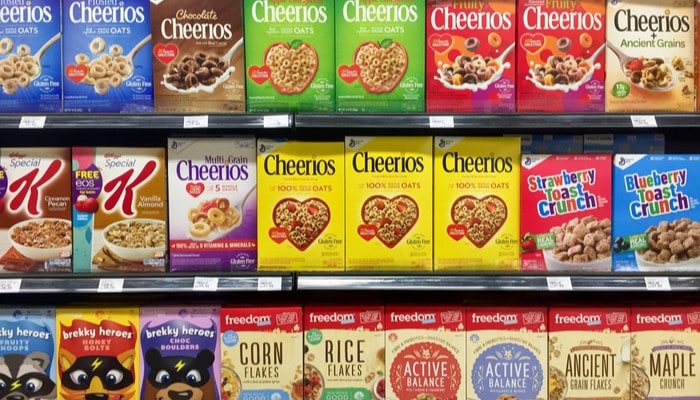
Quality Control in Breakfast Cereal Production
Like with all other food production industries, the breakfast cereal production process needs to be carefully monitored for quality and sanitation. This means that the equipment used should be cleaned and sterilized regularly, while the grain should be inspected for any foreign matter as soon as it arrives in the factory.
Monitoring Temperature and Moisture and Microbial Growth Surveillance
The temperature and moisture content should also be monitored constantly during the manufacturing process, as well as the quality of the stored cereal. On top of that, the processing of cereal needs to be constantly inspected for any signs of microbial growth. The most common microorganisms to watch out for include Salmonella, fungi, Aspergillus, Penicillium, spore-forming bacteria, and Fusarium. Some of these molds will produce mycotoxins, which can cause severe illness or even death.
While mold contamination in raw cereal grains cannot be prevented entirely, microbial growth can be controlled if sanitary manufacturing practices and equipment are used.
Challenges with Additional Ingredients and Contamination During Production
It’s important to keep in mind that, while microbial growth can be halted when heat is applied, there is the possibility of later contamination when other ingredients are added. These ingredients include:
- Sweeteners,
- Coloring,
- Flavorings,
- Preservatives,
- Vitamins,
- Minerals,
- Other additives.
Transferring the product between different areas of production on bulk material handling equipment can also pose a high risk of contamination (from heating to drying, to coating, and to packaging).
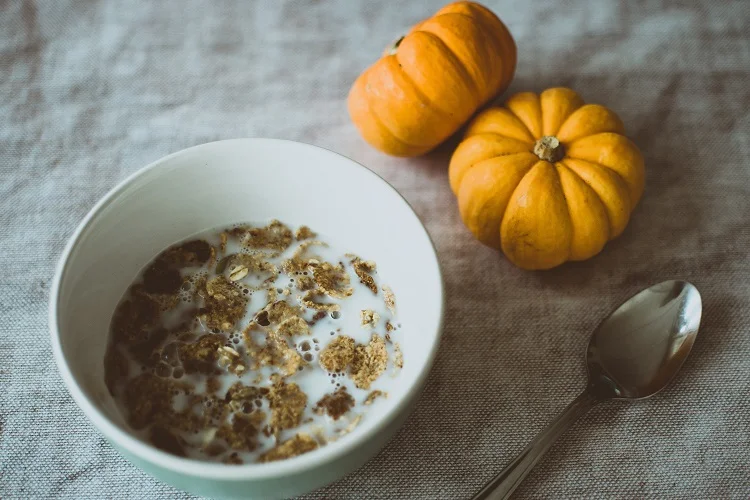
Modernizing Cereal Production With Automation Conveyor Systems
In the past, cereal producers relied on various methods such as bucket elevators, flat-bed conveyors, aeromechanical devices, augers, or pneumatic conveyors to move their cereal within the facility. However, these conveyor belt systems often faced challenges related to cross-contamination, extended downtimes, and frequent maintenance requirements.
The Efficiency of an Industrial Conveyor Belt System
According to Gary Schliebs, Process Engineer at Plus One-Percent Engineered Solutions, “More and more breakfast cereal processors are looking at using this tubular drag conveyor technology right from the initial mixing phase to the blender, then into an extruder. Some major manufacturers are also implementing the system even further downstream, from their extruder to their coating system and through to their packing line. Here is a system that they can go with all the way – an end-to-end package solution that fits perfectly from a cleaning perspective and from an enclosed system point of view, and the risk is absolutely minimal from a contamination or hygiene issue.”
A belt conveyor system, including a conveyor belt for a warehouse or a custom conveyor belt for food, has been shown to mitigate many of these risks and inefficiencies effectively. Tubular drag conveyor systems will be able to integrate with an existing cereal production process, transporting cereal without the issue of contamination or product damage. This is also coupled with easy cleaning and quick changeovers, far outpacing any other type of conveyor system used in cereal production.
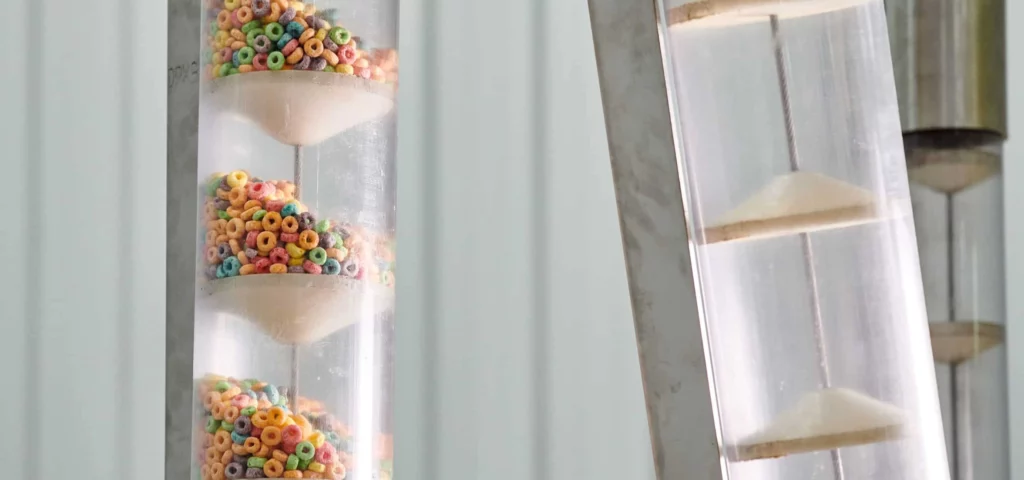
Revolutionize Your Cereal Production with Cablevey Conveyors
The evolution of cereal production has seen significant advancements in conveyor technology, and tubular drag cable conveyors have emerged as the game-changer in this industry. Overcoming the limitations of traditional conveyor systems, Cablevey Conveyors’ innovative tubular drag conveyors provide a comprehensive solution for cereal producers seeking increased efficiency, reduced downtime, and improved hygiene standards.Take the next step towards revolutionizing your cereal production process with Cablevey Conveyors. Contact us today to discuss how our tubular drag cable conveyors can elevate your operations, increase productivity, and maintain the highest standards of hygiene and quality.

